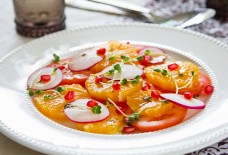Beginners Guide to Cooking in an Arab Kitchen: Pickling
Before the age of refrigeration, pickling was a common form of food preservation. There is evidence of pickling in Ancient Mesopotamia, circa 2400 BC. This preservation method is still used in some parts of the Arab world today. While this is typically a method to gear up for the winter and preserve food, it has also become an important facet of culture and cooking. The means of pickling have evolved from simple methods, such as just salt-packing to also include more elaborate and flavorful recipes.
Pickling for Beginners
What is pickling? Pickling is the act of immersing fresh fruits or vegetables into an acidic brine or a salty mixture. By pickling or salting fresh fruits or vegetables, the salt/acid draws our moisture that proliferates bacteria.
What can be pickled? There are so many vegetables and fruit items that can be pickled! Most people immediately think of only pickled cucumbers, but many other fruits and vegetables can also be pickled; these include beets, bell peppers, blueberries, radishes, tomatoes, turnips, and more!
Do all pickled products taste similar to store-bought pickles? NO! Pickled fruits and vegetables are not just pickled the same way dill pickles are made. Pickled products can be sweet, sour, salty, hot, or a variety of other flavors. This article explains pickling in general but specifically, around the Arab World.
Pickling in the Arab World
Pickled vegetables are used as essential accompaniments to dishes throughout the Middle East, North Africa, the Balkans, and Greece. While many other countries and regions also pickle various products, pickling is an important facet of cooking in the Arab world.
In Lebanon, when the fall months are approaching and it becomes increasingly more difficult for a fruitful harvest, the ancient and traditional response is mouneh, which means “to store”. At this time, many people in the Levante area would take up their bountiful harvest and get to work pickling to save their labor throughout the winter.
A popular commodity throughout the Arab world is pickled turnips. Many people throughout the region call these “lift”. When making Lift, many of them would cut up the turnips into thick little chunks or slices. The brine will primarily be salt and vinegar. It is also common when pickling turnips, they slice up some beets and add them to the brine. This will give them a lovely and appetizing pink color. Some Arab people choose to add jalapenos, sliced lemons, red chili pepper flakes, garlic, and other spices that will enhance the vegetable they are pickling.
Pickled TurnipsWhile these pickled vegetables are typically savory, there are also variations in order to make a sweeter treat! For more examples of various pickled treats, read this article.
The pickled vegetables typically do not serve as a stand-alone meal, but they do act as a great compliment to any dishes, from gyro, falafel, chicken, or kebabs. There is no going wrong with pickled vegetables as a side or appetizer!



